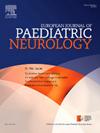Disruptive lesions can cause developmental anomalies in the fetal brain: Mini-review
IF 2.3
3区 医学
Q3 CLINICAL NEUROLOGY
引用次数: 0
Abstract
The development of the fetal central nervous system (CNS) is a complex process influenced by genetic, environmental, and physiological factors. The absence of identifiable genetic variants and low risk of recurrence in families with certain brain malformations has led to the hypothesis that disruptive events may play a critical role in the development of brain malformations. These events include disruption of blood flow, ischemia, hemorrhage, placental insufficiency, prenatal drug exposure (e.g cocaine), and infections (e.g CMV). Likely disruptive anomalies include polymicrogyria (PMG), cerebellar hypoplasia, septo-optic dysplasia (SOD), absent septum pellucidum, and Dandy-Walker malformation (DWM). The timing of these disruptions is expected to reflect the stages of fetal brain development. Understanding the mechanisms behind disruptive-developmental anomalies of the fetal CNS is crucial for improving prenatal screening, counseling strategies, and potential interventions.
破坏性病变可导致胎儿大脑发育异常:简要回顾
胎儿中枢神经系统(CNS)的发育是一个受遗传、环境和生理因素影响的复杂过程。在某些脑畸形的家庭中,缺乏可识别的遗传变异和低复发风险导致了破坏性事件可能在脑畸形的发展中起关键作用的假设。这些事件包括血流中断、缺血、出血、胎盘功能不全、产前药物暴露(如可卡因)和感染(如巨细胞病毒)。可能的破坏性异常包括多小回畸形(PMG)、小脑发育不全、视中隔发育不良(SOD)、透明中隔缺失和Dandy-Walker畸形(DWM)。这些中断的时间预计将反映胎儿大脑发育的阶段。了解胎儿中枢神经系统破坏性发育异常背后的机制对于改善产前筛查、咨询策略和潜在干预措施至关重要。
本文章由计算机程序翻译,如有差异,请以英文原文为准。
求助全文
约1分钟内获得全文
求助全文
来源期刊
CiteScore
6.30
自引率
3.20%
发文量
115
审稿时长
81 days
期刊介绍:
The European Journal of Paediatric Neurology is the Official Journal of the European Paediatric Neurology Society, successor to the long-established European Federation of Child Neurology Societies.
Under the guidance of a prestigious International editorial board, this multi-disciplinary journal publishes exciting clinical and experimental research in this rapidly expanding field. High quality papers written by leading experts encompass all the major diseases including epilepsy, movement disorders, neuromuscular disorders, neurodegenerative disorders and intellectual disability.
Other exciting highlights include articles on brain imaging and neonatal neurology, and the publication of regularly updated tables relating to the main groups of disorders.

 求助内容:
求助内容: 应助结果提醒方式:
应助结果提醒方式:


